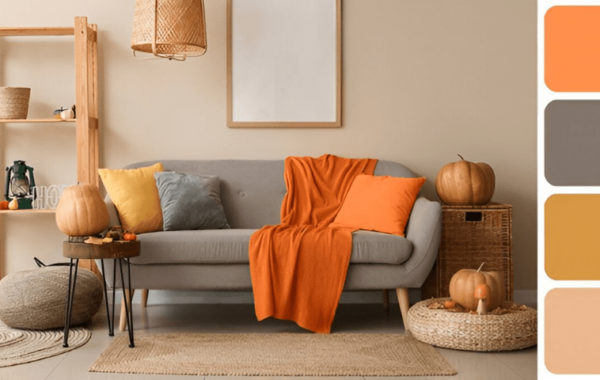Interior design is an art and a science that focuses on uplifting the interior of a space to create a more aesthetically satisfying and functional environment. Whether you’re redesigning your home or commercial space, understanding the fundamental rules of interior design can significantly affect the project outcome. These rules provide a framework for creating harmonious, balanced, and visually appealing spaces that meet that needs and preferences of the occupants.
From achieving balance and harmony to selecting the right color schemes and lighting, these principles guide designers in making informed decisions that contribute to the overall success of the design. These interior design rules or guidelines will help you turn any area into a stunning and useful setting that expresses your specific sense of interior fashion and individuality.
Key Interior Design Rules:
Interior design rules are principles and guidelines that help create aesthetically pleasing, functional, and harmonious spaces. While creativity and personal style play significant roles, these functional rules provide a framework for successful interior design.
1.Balance
Symmetrical balance:
- Creates a mirror image on either side of a central point, often used in traditional interiors.This type of balance conveys a sense of order and stability, making it perfect for formal spaces.
Asymmetrical balance:
- Achieves balance through dissimilar objects that have equal visual weight, offering a more dynamic look.It introduces a sense of movement and can make a space feel more relaxed and inviting.
Radial Balance:
- Involves elements radiating from a central point, creating a circular balance.This is often seen in round dining tables or seating arrangement around a central focal point.
2.Harmony and Unity
- Ensuring all elements in a space work together to create a cohesive look. Consistency in style, color, and materials helps achieve harmony, making the space feel calm and orderly.
- Unity is achieved by repeating design elements, such as colors, textures, or shapes, throughout the space. This repetition helps tie the room together and create a sense of completeness.
3.Rhythm
Repetition:
- Repeating elements such as colors, shapes, or textures to create visual interest and unity. This technique can lead the eye smoothly around the room, providing a sense of coherence.
Progression:
- Gradually increasing or decreasing the size, color, or other attributes of elements to guide the eye through the space. This creates a sense of depth and perspective, adding to the room’s dynamic quality.
Contrast:
- Placing opposing elements next to each other to create visual interest and drama. Contrast can highlight key features in the space and add a dramatic flair.
4.Proportion and Scale
- Ensuring that the size of elements in a space relates well to each other and the overall space. A large piece of furniture in a small room can overwhelm, while small items in a large space can feel lost.
- Proper proportion and scale help create a balanced and harmonious environment. This involves considering the dimensions of the room and the relative sizes of all elements within it.
5.Emphasis
- Creating a focal point in the room that draws attention, such as a fireplace, artwork, or a striking piece of furniture. This helps anchor the space and provides a visual starting point for the room’s design.
- Other elements should complement this focal point, not compete with it. Proper emphasis ensures that the room has a clear visual hierarchy and focal interest.
6. Colour
- Using color to set the mood and define the character of a space. Different colors can evoke different emotions and atmospheres, from calming blues to energizing reds.
60-30-10 Rule:
- Distribute colors in a room in a proportion of 60% dominant color, 30% secondary color, and 10% accent color for balance. This rule helps maintain harmony and balance in the color scheme.
7.Light, Texture and Pattern
- Incorporating natural and artificial lighting to enhance the ambience and functionality of a space. Good lighting can transform the feel of a room and highlight key design elements.
- Incorporating a mix of ambient, task, and accent lighting adds depth and enhances the visual appeal of a space. Each type of lighting serves a different purpose, and together, they can create a well-lit, balanced environment.
- Mixing different types of textures and patterns to add depth and interest. Textures can be smooth, rough, soft, or hard, each adding a different tactile element to the design.
- Smooth and rough textures, as well as varying patterns, can create a rich, dynamic look. Patterns add a visual treat, give more interest and can be used to reinforce any theme or interior style of the room.
8.Functionality
- Ensuring the space serves its intended purpose effectively. This includes considering traffic flow, ergonomics, and the needs of the occupants.
- Functional design ensures that the space is not only beautiful but also practical and comfortable to use. This involves thoughtful planning and the selection of appropriate furniture and fixtures.
9.Details
- Paying attention to small elements such as trim, hardware, and accessories that contribute to the overall design. These details can elevate the space and tie the design together.
- Well-chosen details can add personality and character to a room. They help complete the look and ensure that every aspect of the design is cohesive and considered.
Additional Interior Design Rules & Tips
- Personalization: Reflect the personality and preferences of the occupants through personal touches and unique elements.
- Consistency: Maintain a consistent design theme or style throughout the space for a cohesive look.
- Flexibility: Designing spaces that can adapt to various needs and preferences over time.
Applying Interior Design Rules: The Cibi+Simeon Approach
- Cibi+Simeon Designs is one of the top interior designers in Chennai with over eight years of experience and more than 100 satisfied clients.
- Our interior designers skillfully integrate fundamental interior design principles to create spaces that are both practical and artistically beautiful.
- They carefully consider the proportion and scale of each element to achieve a sense of balance, ensuring that furniture and decor fit harmoniously within the space.
- Symmetrical balance is used for a formal look, while asymmetrical balance is used for a more dynamic feel, consistently delivering visual appeal.
- Functionality is at the core of our design motto, ensuring spaces serve their intended purpose effectively while still being beautiful.
- We pay meticulous attention to lighting, combining natural and artificial sources to enhance the ambience and highlight key features.
- Texture and pattern are thoughtfully mixed to add depth and interest.
- Careful selection of materials and finishes ensures durability and elegance.
- We emphasize the importance of details, from hardware to accessories, ensuring every element contributes to the overall look and feel of the space.
- Our approach results in well-designed, cohesive environments that reflect the client's unique style and needs.
Mastering Interior Design Rules and Techniques
Mastering these fundamental & golden rules of interior design is essential for designing areas that are both visually attractive and efficient. By adhering to principles such as balance, harmony, rhythm, proportion, and emphasis, designers can craft environments that resonate with aesthetic beauty and practical utility. Cibi+Simeon Designs, the best interior designers in Chennai – exemplifies this mastery, seamlessly integrating these principles into our projects to deliver outstanding results. This ability to balance form and function while maintaining cohesion and visual interest is a testament to our interior design firm’s expertise. Embracing these top interior design rules not only enhances the overall quality of a space but also ensures that it serves its known purpose effectively, providing a harmonious and enjoyable environment for all who experience it.



